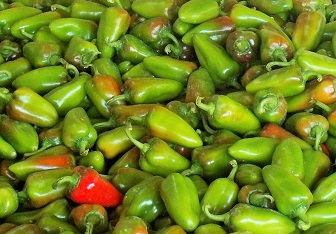Fruit vegetables are collectively one of the many high-value crops that entrepreneurial farmers grow.
Consequently, many companies engage in the breeding of superior varieties of vegetable crops such as tomato, eggplant, peppers (Capsicum), bitter gourd, bottle gourd, string beans, and many more.

These vegetables are a common scene in wet market stalls. Likewise, these are commonly grown in residential backyards.
Some even utilize the boundary fences as trellises for climbing plants such as string beans or pole sitao, lima beans, and winged beans.
Standing trees are likewise used for climbers with relatively large fruits like bottle gourd, luffa, and chayote.
But did you know that one fruit vegetable became the subject of a legal controversy?
In the case of tomatoes, the issue of whether it was a fruit or a vegetable had to be decided by the US Supreme Court. Click here to read.
Examples of Fruit Vegetables
Listed in Table LV-4 are examples of fruit vegetables. The list is not exhaustive.
Table LV-4. Examples of fruit vegetables from which botanical fruits are harvested for culinary uses.
| Crop Name | Scientific Name | Family | Collective Name for Members of the Family, Other Info |
| Bottle gourd, upo | Lagenaria siceraria | Cucurbitaceae | Cucumber/Gourd family, also called Cucurbits |
| Breadnut, Seeded breadfruit, camansi | Artocarpus altilis | Moraceae | Mulberry family |
| Charantia, bitter melon, bitter gourd, ampalaya | Momordica charantia | Cucurbitaceae | Cucumber/Gourd family, also called Cucurbits; the leaves with young stems are also eaten blanched or as ingredient in many vegetable dishes. |
| Chayote | Sechium edule | Cucurbitaceae | Cucumber/Gourd family, also called Cucurbits; chayote tops consisting of young leaves and stems are also cooked as vegetable. |
| Cucumber | Cucumis sativus | Cucurbitaceae | Cucumber/Gourd family, also called Cucurbits; usually consumed raw but also cooked as an ingredient in some food recipes. |
| Eggplant, aubergine | Solanum melongena | Solanaceae | Nightshade family, also called Solanaceous crops |
| Jackfruit | Artocarpus heterophyllus | Moraceae | Mulberry family; mainly grown for the production of ripe fruit but young fruits are cooked as vegetable. |
| Luffa, loofah, sponge gourd, patola | Luffa acutangula | Cucurbitaceae | Cucumber/Gourd family, also called Cucurbits |
| Okra, Lady’s finger, gumbo | Abelmoschus esculentus | Malvaceae | Mallow family |
| Papaya, pawpaw | Carica papaya | Caricaceae | largely grown for the production of ripe fruit but young fruits are commomly cooked alone or as ingredient of many food recipes. |
| Bell/Sweet Pepper | Capsicum annuum, Grossum group | Solanaceae | Nightshade family, also called Solanaceous crops |
| Hot/Chili Pepper | Capsicum annuum, Longum group | Solanaceae | Nightshade family, also called Solanaceous crops |
| Pumpkin | Cucurbita pepo | Cucurbitaceae | Cucumber/Gourd family, also called Cucurbits |
| Tomato | Lycopersicon esculentum | Solanaceae | Nightshade family, also called Solanaceous crops |
| Squash, kalabasa | Cucurbita maxima | Cucurbitaceae | Cucumber/Gourd family, also called Cucurbits |
| Snap bean, kidney bean | Phaseolus vulgaris | Fabaceae/Leguminosae | Bean/Pea family, also called Legumes |
| String bean, Pole sitao, yardlong bean, sitaw | Vigna unguiculata subsp. sesquipedales | Fabaceae/Leguminosae | Bean/Pea family, also called Legumes |
| Sweet corn | Zea mays | Poaceae/Gramineae | Grass family; young ears, or “baby corn”, and “green corn” are also harvested from flint- and dent-type corn varieties. |
| Winged bean | Psophocarpus tetragonolobus | Fabaceae/Leguminosae | Bean/Pea family, also called Legumes |
Click here to read What is a Fruit
REFERENCES
- HILL A. 1972. Economic Botany. 2nd ed. New Delhi: Tata McGraw-Hill Publishing Co. Ltd. 560 p.
- PEEL L. 2004. HarperCollins Practical Gardener: Kitchen Garden. New York, NY: HarperCollins Publishers Inc. 176 p.
- SIMPSON MG. 2010. Plant Systematics. 2nd ed. San Diego, CA: Elsevier Inc. 740 p.
- The Essential Gardening Encyclopedia. 2003. San Francisco, CA: Fog City Press. 608 p.
